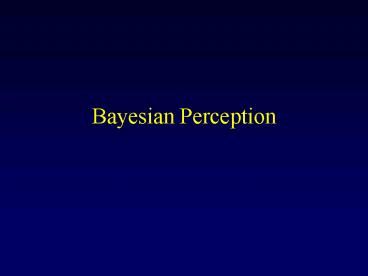Bayesian Perception PowerPoint PPT Presentation
1 / 74
Title: Bayesian Perception
1
Bayesian Perception
2
General Idea
- Perception is a statistical inference
- The brain stores knowledge about P(I,V) where I
is the set of natural images, and V are the
perceptual variables (color, motion, object
identity) - Given an image, the brain computes P(VI)
3
General Idea
- Decisions are made by collapsing the distribution
onto a single value - or
4
Key Ideas
- The nervous systems represents probability
distributions. i.e., it represents the
uncertainty inherent to all stimuli. - The nervous system stores generative models, or
forward models, of the world (e.g. P(IV)). - Biological neural networks can perform complex
statistical inferences.
5
A simple problem
- Estimating direction of motion from a noisy
population code
6
Population Code
Tuning Curves
Pattern of activity (A)
7
Maximum Likelihood
8
Maximum Likelihood
- The maximum likelihood estimate is the value of
q maximizing the likelihood P(Aq). Therefore, we
seek such that - is unbiased and efficient.
9
(No Transcript)
10
MT
V1
11
Preferred Direction
MT
V1
Preferred Direction
12
Linear Networks
- Networks in which the activity at time t1 is a
linear function of the activity at the previous
time step.
13
Linear Networks
Equivalent to population vector
14
Nonlinear Networks
- Networks in which the activity at time t1 is a
nonlinear function of the activity at the
previous time step.
15
Preferred Direction
MT
V1
Preferred Direction
16
Maximum Likelihood
17
Standard Deviation of
18
Standard Deviation of
19
Weight Pattern
Amplitude
Difference in preferred direction
20
Performance Over Time
21
(No Transcript)
22
General Result
- Networks of nonlinear units with bell shaped
tuning curves and a line attractor (stable smooth
hills) are equivalent to a maximum likelihood
estimator regardless of the exact form of the
nonlinear activation function.
23
General Result
- Pro
- Maximum likelihood estimation
- Biological implementation (the attractors
dynamics is akin to a generative model ) - Con
- No explicit representations of probability
distributions - No use of priors
24
Motion Perception
25
The Aperture Problem
26
The Aperture Problem
27
The Aperture Problem
28
The Aperture Problem
29
The Aperture Problem
30
The Aperture Problem
31
The Aperture Problem
32
The Aperture Problem
33
The Aperture Problem
34
The Aperture Problem
35
The Aperture Problem
36
The Aperture Problem
37
The Aperture Problem
Vertical velocity (deg/s)
Horizontal velocity (deg/s)
38
The Aperture Problem
Vertical velocity (deg/s)
Horizontal velocity (deg/s)
39
The Aperture Problem
40
The Aperture Problem
Vertical velocity (deg/s)
Horizontal velocity (deg/s)
41
The Aperture Problem
Vertical velocity (deg/s)
Horizontal velocity (deg/s)
42
Standard Models of Motion Perception
- IOC interception of constraints
- VA Vector average
- Feature tracking
43
Standard Models of Motion Perception
IOC
VA
Vertical velocity (deg/s)
Horizontal velocity (deg/s)
44
Standard Models of Motion Perception
IOC
VA
Vertical velocity (deg/s)
Horizontal velocity (deg/s)
45
Standard Models of Motion Perception
IOC
VA
Vertical velocity (deg/s)
Horizontal velocity (deg/s)
46
Standard Models of Motion Perception
IOC
VA
Vertical velocity (deg/s)
Horizontal velocity (deg/s)
47
Standard Models of Motion Perception
- Problem perceived motion is close to either IOC
or VA depending on stimulus duration,
eccentricity, contrast and other factors.
48
Standard Models of Motion Perception
- Example Rhombus
Percept VA
Percept IOC
IOC
IOC
VA
VA
Vertical velocity (deg/s)
Vertical velocity (deg/s)
Horizontal velocity (deg/s)
Horizontal velocity (deg/s)
49
Bayesian Model of Motion Perception
- Perceived motion correspond to the MAP estimate
50
Prior
- Human observers favor slow motions
51
Likelihood
- Weiss and Adelson
52
Likelihood
53
Likelihood
54
Bayesian Model of Motion Perception
- Perceived motion correspond to the MAP estimate
55
Motion through an Aperture
- Humans perceive the slowest motion
56
Motion through an Aperture
Likelihood
50
Vertical Velocity
0
-50
-50
0
50
ML
Horizontal Velocity
50
50
Vertical Velocity
Vertical Velocity
MAP
0
0
-50
-50
Prior
Posterior
-50
0
50
-50
0
50
Horizontal Velocity
Horizontal Velocity
57
Motion and Constrast
- Humans tend to underestimate velocity in low
contrast situations
58
Motion and Contrast
Likelihood
50
Vertical Velocity
0
-50
High Contrast
-50
0
50
ML
Horizontal Velocity
50
50
Vertical Velocity
Vertical Velocity
MAP
0
0
-50
-50
Prior
Posterior
-50
0
50
-50
0
50
Horizontal Velocity
Horizontal Velocity
59
Motion and Contrast
Likelihood
50
Vertical Velocity
0
-50
Low Contrast
-50
0
50
ML
Horizontal Velocity
MAP
50
50
Vertical Velocity
Vertical Velocity
0
0
-50
-50
Prior
Posterior
-50
0
50
-50
0
50
Horizontal Velocity
Horizontal Velocity
60
Motion and Contrast
- Driving in the fog in low contrast situations,
the prior dominates
61
Moving Rhombus
Likelihood
50
50
Vertical Velocity
Vertical Velocity
0
0
-50
-50
High Contrast
-50
0
50
-50
0
50
IOC
Horizontal Velocity
Horizontal Velocity
MAP
50
50
Vertical Velocity
Vertical Velocity
0
0
-50
-50
-50
0
50
-50
0
50
Prior
Posterior
Horizontal Velocity
Horizontal Velocity
62
Moving Rhombus
Likelihood
50
50
0
Vertical Velocity
0
Vertical Velocity
-50
-50
Low Contrast
-50
0
50
-50
0
50
IOC
Horizontal Velocity
Horizontal Velocity
50
50
MAP
Vertical Velocity
Vertical Velocity
0
0
-50
-50
-50
0
50
-50
0
50
Prior
Posterior
Horizontal Velocity
Horizontal Velocity
63
Moving Rhombus
64
Moving Rhombus
- Example Rhombus
Percept VA
Percept IOC
IOC
IOC
VA
VA
Vertical velocity (deg/s)
Vertical velocity (deg/s)
Horizontal velocity (deg/s)
Horizontal velocity (deg/s)
65
Barberpole Illusion
66
Plaid Motion Type I and II
67
Plaids and Contrast
68
Plaids and Time
- Viewing time reduces uncertainty
69
Ellipses
- Fat vs narrow ellipses
70
Ellipses
- Adding unambiguous motion
71
Biological Implementation
- Neurons might be representing probability
distributions - How?
72
Biological Implementation
- Encoding model
73
Biological Implementation
- Decoding
- Linear decoder deconvolution
74
Biological Implementation
- Decoding nonlinear
- Represent P(VW) as a discretized histogram and
use EM to evaluate the parameters

